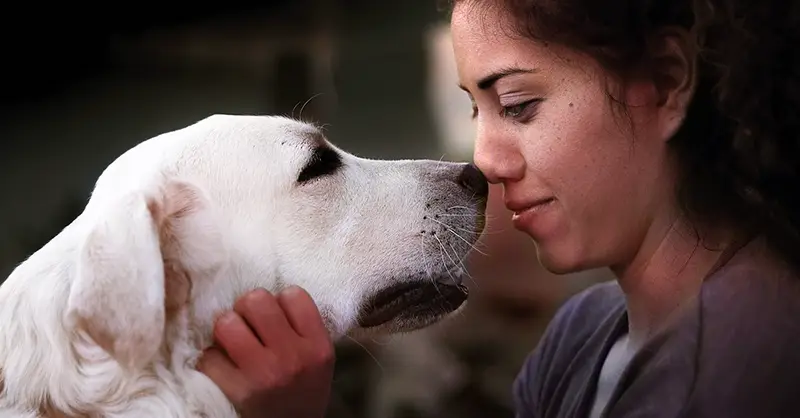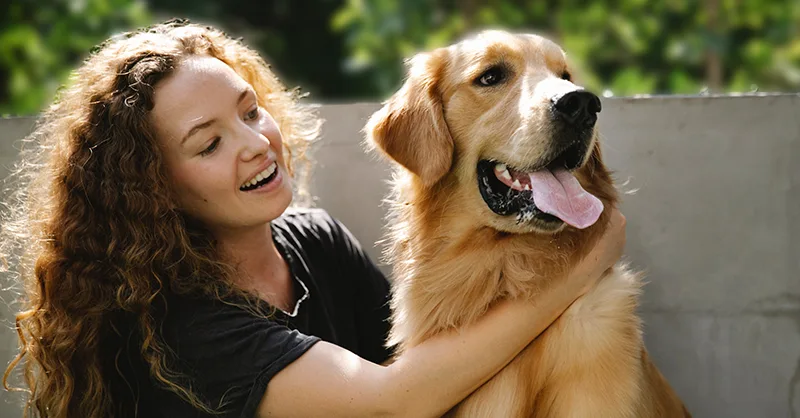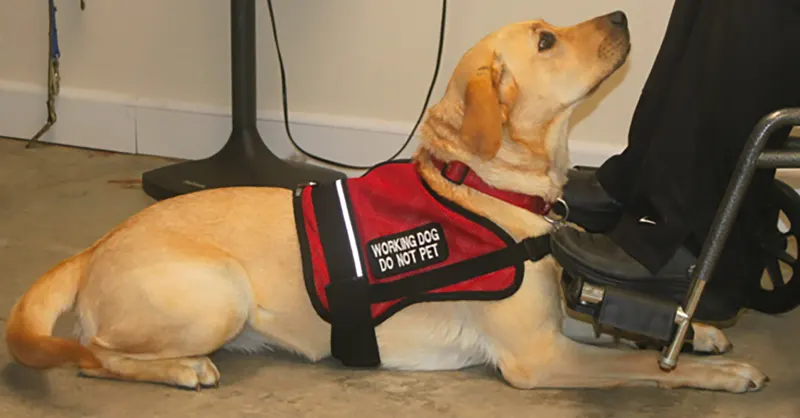Archive for the ‘Service Dog Tips’ Category
Service Dogs work to provide assistance to their owners both inside and outside the house. Many handlers like to keep them close by in case they need the help their Service Dog has been trained for. But, while there are no rules that a Service Dog must accompany their handlers 24/7, it is up to the individual to decide when they need their Service Animal close by. To understand what considerations that decision might involve, read on below.
Am I Allowed to Leave my Service Dog Alone at Home?The Americans with Disabilities Act (ADA) has not specified any rules or regulations that state that a person must have their Service Dog with them at all times. If a handler feels as if they need their Service Dog with them whenever they leave the house, they are allowed to bring them along.
However, if the situation commends to leave their Service Dog at home, that’s okay. In fact, there may be circumstances where the handler may be unable to bring their Service Dog. In these cases, the handler will need to decide how to manage their symptoms in their animal’s absence. Remember, Service Dogs are to assist, not to burden.
A Person as a Substitute for a Service DogIf a handler has to leave their Service Dog at home, but is not confident enough to encounter the situation alone, there are other ways that they can manage their symptoms. For example, the handler could be accompanied by a person who is aware of the individual’s needs. While the friend may not be able to detect an issue the way a Service Dog would, they would be able to support them while it happens and direct them to the proper supports. This gives the handler the opportunity to be without their Service Dog, but have support if need be.
Service Dog at home waiting for their handler to return. When In Doubt, Stay with the Service DogIn more serious cases, if a handler is unable to bring their Service Dog to a certain location, but can’t function without them, it’s recommended that they send somebody to go run the errand instead. The handler can stay in the presence of their Service Dog, while a friend can get the task completed for them.
Get a Service Dog ID for ConfidenceShould a handler not feel confident enough to bring their Service Dog to specific locations, they may consider registering their Service Dog and purchase a Service Dog ID as well as a Service Dog vest. While it’s not a requirement, some individuals feel more confident bringing their Service Dogs along if it is visibly marked as a Service Animal.
The Handler must DecideUltimately, except in extreme cases, it’s up to the handler to decide whether or not they bring their Service Dog with them out and about. The Americans with Disabilities Act (ADA) ensures that the majority of public places allow Service Dogs. Nonetheless, every handler should have a plan in place for the case they run into a scenario where their Service Dog is unable to accompany them.
A Psychiatric Service Dog (PSD) is a Service Animal specifically trained to support individuals diagnosed with a mental illness. A well-trained PSD is able to ease symptoms caused by the mental disability and can comfort their handler in times of distress.
In this article, we’ll cover how to be approved for a PSD, what to look for when selecting a dog, and how to train a Psychiatric Service Dog to become a handler’s life-saver.
Is there a registry for Psychiatric Service Dogs?The Americans with Disabilities Act (ADA) does not require any registration for Service Dogs. Psychiatric Service Dogs can accompany their handlers unmarked and without any id or paperwork. However, some handlers find it reassuring to register their Service Dogs and to purchase a vest and id. It helps them to communicate that their dog is, in fact, a working Service dog, and their rights should be respected.
1) Speak with a Health Care Professional about Psychiatric Service DogsA Psychiatric Service Dog can only be acquired if a health professional gives a diagnosis of mental illness. According to the Americans with Disabilities Act (ADA), a Service Dog must be able to assist their handler with tasks that directly relate to their disability. To be eligible for a Psychiatric Service Dog the diagnosis may include:
Generalized Anxiety Disorder Depression Panic Attacks Obsessive-Compulsive Disorder Post-Traumatic Stress Disorder (PTSD) Schizophrenia AgoraphobiaWith this diagnosis, an individual is allowed to get a Psychiatric Service Dog and train it to complete tasks that help them with their symptoms.
2) Obtain your Psychiatric Service DogWhen starting to look for a Psychiatric Service Dog several considerations are necessary. Most dogs have the potential of being a Service Dog but not every dog can perform the tasks their handlers require to help reduce the impact of the mental disorder.
Where to find a dogTo select the perfect Psychiatric Service Dog the two most common ways are:
Purchase from an organization that specifically trains PSDs. Adopt from a local animal shelter.Either way, it is crucial to find a dog that is best suited for the work ahead. Among these considerations are the dog’s characteristics, breed as well as its age and health.
CharacteristicsWhen choosing a dog, the handler must be aware of certain behavioral traits. While there are no specific regulations that a handler must follow, it’s important that the dog displays the following qualities:
Eager to please Easily trainable Non-aggressive Accepting of strangers Disciplined Strong work ethicDogs with these traits tend to succeed as Service Dogs, as they want to please their handlers and enjoy learning new tasks. It is crucial to adopt a dog that enjoys working on specific tasks. It’s important not to choose a dog for the wrong reasons; handlers may need to change the PSD if they seem to be in distress while training or cannot comprehend the tasks they should perform.
A handler needs to take special consideration finding a Psychiatric Service Dog to guarantee they are a perfect fit for the challenges ahead.
BreedWith the right characteristics, any dog has the potential to become a Psychiatric Service Dog. The ADA does not restrict breeds that qualify to become a Service Animal and therefore facilities and landlords do not have the right to exclude a Service Dog based on breed. However, among the dog breeds that generally excel in this type of work are:
Labrador Retrievers German Shepherds Border Collies Poodles Golden RetrieversThese breeds share traits, such as high levels of trainability, desire to please, intense focus, and generally good temperament. Dogs with these characteristics usually do well in training and are able to form a strong bond with their handlers.
Health and ageFor any Service Animal, it is essential that they are in top health condition. Any health issue, such as diabetes or arthritis, could hinder the Psychiatric Service Dog of performing the tasks in the time needed and therefore become an additional burden in times of distress.
To get the best out of the Psychiatric Service Dog these points need to be recognized:
An inaugural visit to the vet is absolutely needed, to make sure the dog is in top condition. Once the PSD is in service, taking well care of them and revisiting the vet for regular checkups is necessary. All Service Dogs should be neutered. This will make males less aggressive and females without distraction when in heat. The dog should be at least 6 months old and more importantly have outgrown the puppy phase.If the handler understands and can accommodate these prerequisites, finding the perfect Psychiatric Service Dog is merely a matter of time. However, it’s still only halfway through the process as the next, big step of training the dog will begin.
3) Train your Psychiatric Service DogEach dog will respond differently to learning the tasks needed; some are naturally intuitive and already understand what their handler needs, others might require several training sessions to master the complexity of the task. Therefore, a Psychiatric Service Dog doesn’t need to attend any specific training program. The only requirement is that the PSD is trained to perform tasks that directly relate to their handler’s disability.
For example a person living with anxiety could train their Psychiatric Service Dog to detect panic attacks. The PSD would alert its owner of an upcoming panic attack, and then work to comfort and support their handler until the attack subsides.
Using a reputable PSD trainerHandlers might want to get the help of a professional Psychiatric Service Dog trainer if they are not confident enough to do all of the training themselves.
The cost of having the PSD trained professionally will differ based on the dog’s ability to learn and the complexity of the tasks needed. Talk to several potential trainers beforehand and get an estimate of the time and effort involved. However, the benefits of having a fully dependable Psychiatric Service Dog at hand could be worth every penny spent.
When looking for a trainer, handlers should put some research into the trainers available in their region. Getting recommendations from other individuals with PSDs are a safe way to be connected with a reputable trainer.
Train yourselfIf the tasks at hand are easy, or the dog and their handler already have a strong bond, training themselves could be an option. Training a service dog might start with basic commands and slowly building up the skills until the PSD knows how to behave in public and stressful situations.
It is important that the Psychiatric Service Dog has enough confidence in performing the special task even in conditions when the handler might not be able to give proper instructions. Following a strict regimen will help the PSD to learn what is needed and to perform the tasks with few to no errors.
As long as the Psychiatric Service Dog is able to complete the tasks directly related to the handler’s mental disability, it does not matter who trains them.
4) Be aware of the stipulations surrounding Psychiatric Service DogPer the ADA, handlers are allowed to bring their Service Dogs into pubic establishments that normally wouldn’t allow pets, such as:
Apartment complexes Hotels Restaurants Movie theaters Retail stores and marketsAlthough the ADA doesn’t require Psychiatric Service Dogs to be registered, handlers can bring their PSD unmarked into these buildings. Nevertheless, some handlers do prefer to register their Service Dogs to ensure that their rights will be respected. Establishment owners are unable to legally ask if a dog is a Service Animal. They are, however, allowed to ask two questions:
Does the dog assist the handler with a task related to their disability? And if so, what tasks do they perform?Handlers should be prepared to answer the two questions but also remain aware of the limitations of what can be asked.
Patience and knowledge will lead to the perfect Psychiatric Service DogThe path to finding and training a Psychiatric Service Dogs for the tasks needed may be long. Still, once the PSD is ready and can help their handler to overcome symptoms caused by the mental disability, the handler’s life will become safer and more fulfilling.
Like all canines, Service Dogs will need to be vaccinated. In fact, they may need these immunity-building aids even more so than the average pet. Find out why and other relevant information on vaccines and Service Dogs within this article.
The Service DogUnder the definition stated by the Americans With Disabilities Act (ADA), Service Dogs are canines that provide a specific service to an individual with a physical disability.
Service Dogs are no longer just for people with sight or hearing impairments. They are now employed for several different conditions ranging from mobility to seizure alerting to picking up dropped items.
Service Dogs play a vital role in providing disabled people with the freedoms others often take for granted.
Where Can Service Dogs Go?People who need Service Dogs are afforded the freedom of bringing them everywhere they go. These areas include public places (malls, grocery stores, libraries, doctor’s clinics, etc.), as well as the cabin of an aircraft, and no-pets policy housing.
Legitimate Service Dogs cannot be turned away unless they are deemed a threat to the people they will come in contact with; however, this is rare as Service Dogs are chosen for their docile temperaments, as well as their trainability to commands and task-orientated work.
What Do Vaccinations Do?Vaccinations are injected just under your dog’s skin. They work by introducing a small amount of the infectious organism into your dog’s system. As your dog’s immune system recognizes the organism as “foreign,” it begins to fight them, which in turn builds up antibodies.
Each time your dog is exposed to this “infectious” substance, (ie. through a vaccination) it will be better able to identify those agents, releasing antibodies more quickly. So if your Service Dog were to encounter an infected dog (or other animals) with the disease it has been vaccinated for, it would not be affected.
A healthy Service Dog is a good Service Dog Vaccinations and Service DogsAll dogs should be vaccinated against the primary illness common to the canine. They involve “core” vaccinations (given to prevent common diseases), and “non-core” vaccinations for dogs that are at a higher risk of these ailments.
Core vaccinations are: Canine distemper Canine parvovirus Canine adenovirus 1 infection Rabies Non-core vaccinations include: Leptospirosis Lyme disease (caused by ticks) Canine cough complex Canine influenzaBoth core and non-core vaccinations are beneficial for Service Dogs to prevent illness or infections. As a Service Dog will be out in the general public visiting various places, they need a higher level of disease protection and prevention.
Vaccinated dogs will be more readily accepted onto aircrafts, into public places, and into different states and countries.
A Service Dog traveling in foreign land What Are My Service Dog’s Health Risks?The risk of your dog contracting specific diseases dramatically depends on the area you live in and where you are taking your Service Dog. Core vaccinations should always be administered to ensure your dog is safe-guarded against the main dog diseases.
However, you may want to discuss the non-core vaccine options with your veterinarian. He or she will help you determine if your Service Dog is at a high, medium or low risk for the following conditions;
Leptospirosis – dogs are at a higher risk when exposed to wildlife environments (ponds or rural settings). Lyme disease – transmitted by deer ticks, commonly found on the whitetail deer. Although exposure and infection don’t always occur when frequenting an area with a deer population, this vaccine should be considered. Canine Cough – includes bordetella and parainfluenza, which are respiratory infections spread between dogs. Places like boarding facilities, dog shows, dog classes, and dog parks are all high-risk areas. Canine influenza – a relatively new vaccine. The disease is similar to human influenza with similar symptoms (coughing, sneezing, discharge, fever, etc.). It should be administered yearly for dogs considered at a higher risk. How to remove ticks from my dog (click for larger view) Service Dogs and VaccinationsAll dogs, including Service Dogs, should be examined by a veterinarian at least once-a-year to determine their overall health and the risks of disease. This will assure that your Service Dog remains healthy, is appropriately vaccinated for both core and non-core conditions, and can perform the tasks needed without interruptions.







